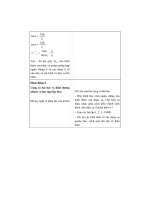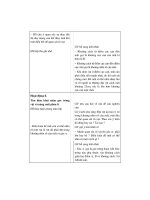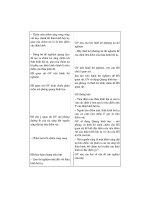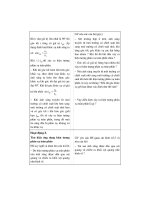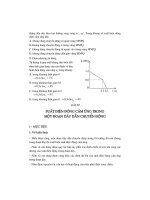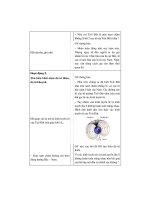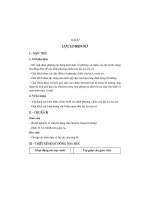bài giảng vật lý chất lượng cao
Bạn đang xem bản rút gọn của tài liệu. Xem và tải ngay bản đầy đủ của tài liệu tại đây (10.08 MB, 97 trang )
PHYSICS 1
PHYSICS 1: MECHANICS AND THERMODYNAMICS
PHYSICS 2: OSCILLATIONS, ELECTRICITY AND MAGNETISM
PHYSICS 3: WAVES, OPTICS AND MODERN PHYSICS
2
Introduction
1. Title: Physics 1
2. Credits: 3
3. Prerequisites:
Analytics analysis
4. Course Description
This course tends to give students opportunity to explore the basic
concepts, laws and application of Mechanics and Thermodynamics,
including:
Properties and laws of motion of particle, rigid body
Relationship among position, velocity and acceleration
Laws of linear momentum, angular momentum and energy
The kinetic theory of gases, thermodynamic quantities
Laws of Thermodynamics
3
Introduction
5. Textbook
1.
Raymond A. Serway and W. Jewett, Physics for Scientists and
Engineers with Modern Physics (9th Edition), Cengage
Learning, USA, 2014
2.
Trần Ngọc Hơi, Phạm Văn Thiều, Vật lý đại cương: Các
nguyên lý và ứng dụng, Tập 1: Cơ học và Nhiệt học, NXB Giáo
dục 2006
Reference Books
3.
Hugh D. Young and Roger A. Freedman, University Physics with
Modern Physics (13th Edition), Pearson Education, USA, 2012
4.
Paul A. Tipler and Gene Mosca, Physics for Scientists and
Engineers (6th Ed.), W. H. Freeman and Company, USA, 2008
5.
David Halliday, Cơ sở vật lý, tập 1, NXB Giáo dục, 2007
4
Introduction
6. Lesson plan
Week
1
2
3
4
Lesson
Preparation of student
Introduction
Chapter 1: Physics and measurement
Read the text book: 2-13
Chapter 2: Motion in one dimension
Read the text book: 21-47
Chapter 3: Montion in two dimensions
Read the text book: 78-98
Chapter 4: The laws of motion
Read the text book: 111-135
Solve problems of chapters 2, 3, 4
Prepare the solution of
problems by group
Chapter 5: Circular motion and other
applications of Newton’s laws
Read the text book: 150-167
Chapter 6: Energy of the system
Read the text book: 177-201
Chapter 7: Conservation of energy
Read the text book: 211-233
5
Introduction
6. Lesson plan
Week
5
6
7
8
Lesson
Preparation of student
Solve problems of chapters 5, 6, 7
Prepare the solution of
problems by group
Chapter 8: Linear momentum and
collisions
Read the text book: 247-279
Chapter 9: Rotation of rigid object about
a fiexd axis
Read the text book: 293-321
Solve problems of chapters 8, 9
Prepare the solution of
problems by group
Chapter 10: Angular momentum
Read the text book: 335-352
Chapter 11: Static equilibrium and
elasticity, Universal gravitation, Fluid
mechanics
Study by your self: 363-449
Introduction to the project of course
6
Introduction
6. Lesson plan
Week
Lesson
Preparation of student
Solve problems of chapters 10
Prepare the solution of
problems by group
Chapter 12: Tempurature and the first
law of Thermodynamics
Read the text book: 568-625
Chapter 13: The kinetic theory of gases
Read the text book: 626-652
10
Chapter 14: Heat engines, entropy and
the second law of Thermodynamics
Read the text book: 653-688
11
Solve problems of chapters 12, 13, 14
Prepare the solution of
problems by group
Represent the result of the project
Work in group to make the
product of the project and to
prepare a report of project
9
12
7
Introduction
7. Assessment Plan
Assessment Types
Assessment Components
Percentages
20%
A1. Learning activities
A1.1. Attendance
A1.2. Homework report
A1.3. Project
A2. Midterm Exam
A2.1. Written Test
20%
A3. Final Exam
A3.1. Written Test
60%
8. Student Responsibilities and Policies:
Attendance: It is compulsory that students attend at least 80%
of the course to be eligible for the final examination.
Missed tests: Students are not allowed to miss any of the tests.
There are very few exceptions
PART 1: MECHANICS
CHAPTER 1: PHYSICS AND MEASUREMENT
PHYSICS AND
MEASUREMENT
CHAPTER 1
PART 1: MECHANICS
9
CHAPTER 1: PHYSICS AND MEASUREMENT
Physics
Physics, the most fundamental physical science, is concerned with
the fundamental principles of the Universe.
The study of physics can be divided into six main areas:
Classical mechanics: concerning the motion of objects that are large
relative to atoms and move at speeds much slower than the speed of light
Relativity: a theory describing objects moving at any speed, even speeds
approaching the speed of light
Thermodynamics: dealing with heat, work, temperature, and the statistical
behavior of systems with large numbers of particles
Electromagnetism: concerning electricity, magnetism, and electromagnetic
fields
Optics: the study of the behavior of light and its interaction with materials
Quantum mechanics: a collection of theories connecting the behavior of
matter at the submicroscopic level to macroscopic observations
PART 1: MECHANICS
10
CHAPTER 1: PHYSICS AND MEASUREMENT
Physics and measurement
Like all other sciences, physics is based on experimental
observations and quantitative measurements.
Objectives: to identify fundamental laws governing natural
phenomena and use them to develop theories
Tool: Language of mathematics (a bridge between theory and
experiment)
Classical physics: includes the principles of classical mechanics,
thermodynamics, optics, and electromagnetism developed before
1900 (Newton mechanics)
Modern physics: a major revolution in physics began near the end
of the 19th century (theories of relativity and quantum mechanics)
PART 1: MECHANICS
11
CHAPTER 1: PHYSICS AND MEASUREMENT
1.1. Standards of length, mass and time
In 1960, an international committee established a set of standards for
the fundamental quantities of science call SI (Système International)
Length
The distance between two points in space
Standard in SI: meter (m)
1960: 1m = the length of the meter was defined as the distance
between two lines on a specific platinum–iridium bar stored under
controlled conditions in France
1960s-1970s: 1m = 1 650 763.73 wavelengths 1 of orange-red
light emitted from a krypton-86 lamp
1983: 1m = the distance traveled by light in vacuum during a time
of 1/299792458 second
PART 1: MECHANICS
12
CHAPTER 1: PHYSICS AND MEASUREMENT
1.1. Standards of length, mass and time
Mass
Standard in SI: kilogram (kg)
1987: 1kg = the mass of a specific platinum–
iridium alloy cylinder kept at the International
Bureau of Weights and Measures at Sèvres,
France
Time
Standard in SI: second (s)
1967: 1s = 9 192 631 770 times the period of
vibration of radiation from the cesium-133 atom
(in an atomic clock)
PART 1: MECHANICS
13
CHAPTER 1: PHYSICS AND MEASUREMENT
1.2. Dimentional analysis
• The dimensions of length l, mass m, and time t are L,
M, and T, respectively.
• Use brackets [ ] to denote the dimensions of a
physical quantity.
• Assume that a quantity f = g(z, y, z) is a function of
quantities x, y and z with the corresponding
dimensions [x], [y] and [z], the dimension of f:
• [f ] = g([x ], [y ], [z ])
• Example:
• The dimensions of speedv = l/t are written [v ] = L/T.
• The dimensions of area A = l × l are [A ] = L × L = L2.
PART 1: MECHANICS
14
CHAPTER 1: PHYSICS AND MEASUREMENT
1.2. Dimensional analysis
• Quantities can be added or subtracted only if they
have the same dimensions.
• The terms on both sides of an equation must have the
same dimensions.
Example 1.1. Analysis of an equation
Show that the expression , where
represents speed,
acceleration, and an instant of time, is dimensionally correct.
• Solve:
• The dimensions of v: [v] = L/T
• The dimensions of at: [at] =
• Therefore, v = at is dimensionally correct because we
have the same dimensions on both sides.
PART 1: MECHANICS
15
CHAPTER 1: PHYSICS AND MEASUREMENT
1.3. Conversion of units
Sometimes it is necessary to convert units from one measurement
system to another or convert within a system.
1 km = 1000 m, 1 m = 10 dm = 100 cm =1000 mm
1 mile (mi)= 1609 m
1 feet (ft) = 0.3048 m, 1 m = 39.37 in.
1 inch (in.) = 0.0254 m, 1 m = 3.281 ft
Example 1.3
36 km/h = ? m/s
200 mi/h = ? m/s
PART 1: MECHANICS
16
CHAPTER 1: PHYSICS AND MEASUREMENT
1.4. Estimates and Order-of-Magnitude
Calculations
•Order
of magnitude is a power often determined as follows
Example 1.4
PART 1: MECHANICS
17
CHAPTER 1: PHYSICS AND MEASUREMENT
1.5. Significant figures
•Significant
figures is the number of numerical digits used to express
the measurement
+ 1; 2 have one significant figure; 12; 2,3 have two SF; 123; 1,56 have
three SF.
+ 1,01; 202 have three SF; 2016; 50,25 have four SF; 30001; 1,1001 have
five SF
+ 0,1; 0,002 have one SF; 0,16; 0,0025 have two SF; 0,102; 0,123 have
three SF
+ 12,00; 2,010 have four SF; 20; 2,0 have two SF; 0,100; 10,0 have three SF
+ Mass of 1500 g is an ambiguous value should use scientific notation
such as g (2 SF), or g (3 SF), or g (4 SF)
+ The same rule holds for numbers less than 1. Ex: (2 SF), (4 SF)
PART 1: MECHANICS
18
CHAPTER 1: PHYSICS AND MEASUREMENT
1.5. Significant figures
•The
rule of determinating the number of significant figures
When multiplying several quantities, the number of significant
figures in the final answer is the same as the number of significant
figures in the quantity having the smallest number of significant
figures. The same rule applies to division
Ex: Report the result of multiplications
The area of a carpet whose length is 15.24 m and whose width is
2.19 m
The area of the disc whose radius is 6.0 cm
PART 1: MECHANICS
19
CHAPTER 1: PHYSICS AND MEASUREMENT
1.5. Significant figures
•The
rule of determinating the number of significant figures
When numbers are added or subtracted, the number of decimal
places in the result should equal the smallest number of decimal
places of any term in the sum or difference
Ex:
Note: The rule for rounding number
The last digit retained is increased by 1 if the last digit dropped is
greater than 5 (Ex: 2.567 2.57)
If the last digit dropped is less than 5, the last digit retained remains as
it is (Ex: 2.564 2.56)
If the last digit dropped is equal to 5, the remaining digit should be
rounded to the nearest even number (Ex: 2.565 2.56, 2.555 2.56)
PART 1: MECHANICS
21
CHAPTER 2: MOTION IN ONE DIMENSION
Introduction
Kinematics: describe the motion of an object while ignoring the
interactions with external agents
Motion in one dimension: motion of an object along a straight line
Particle model: describe the moving object as a particle regardless
of its size (a particle to be a point-like object)
Physical terms
/>motion, particle, kinematics, position, reference point, coordinate
system, velocity, speed, average/instantaneous velocity/speed,
derivative, acceleration, gravity, resistance, period, angular speed,
centripetal acceleration, tangential and radial acceleration, relative
velocity/acceleration
PART 1: MECHANICS
22
CHAPTER 2: MOTION IN ONE DIMENSION
2.1. Position, velocity, speed
•Position
A particle’s position is the location of the particle with respect to
a chosen reference point that we can consider to be the origin of a
coordinate system
Example
One dimension coordinate system
Pictorial representation
Position-time graph
Graphical representation
PART 1: MECHANICS
23
CHAPTER 2: MOTION IN ONE DIMENSION
2.1. Position, velocity, speed
•Displacement
and distance
The displacement of a particle is its change in position in some
time interval
As the particle moves from an initial position
displacement is given by
to a final position , its
Note: Displacement differs from distance
Displacement ()
Distance (d)
change in position
the length of a path
vector quantity
scalar quantity
Ex: After each period of motion of a particle moving in a circle of radius :
PART 1: MECHANICS
24
CHAPTER 2: MOTION IN ONE DIMENSION
2.1. Position, velocity and speed
•Velocity
and speed
The average velocity of a particle is defined as the particle’s
displacement divided by the time interval during which that
displacement occurs:
Dimension: L/T
Note 1: In one dimension motion, the average velocity can be positive or
negative, depending on the sign of the displacement
Note 2: Velocity differs from speed
The average speed of a particle is defined as
PART 1: MECHANICS
25
CHAPTER 2: MOTION IN ONE DIMENSION
2.2. Instantaneous velocity and speed
•Instantaneous
velocity
The instantaneous velocity (or velocity for short) of a particle at a
particular instant in time equals the limiting value of the ratio as
approaches zero:
Note 1: The instantaneous velocity can be positive, negative, or zero
Note 2: Velocity differs from speed
The instantaneous speed (or speed for short) of a particle is defined as the
magnitude of its velocity .


